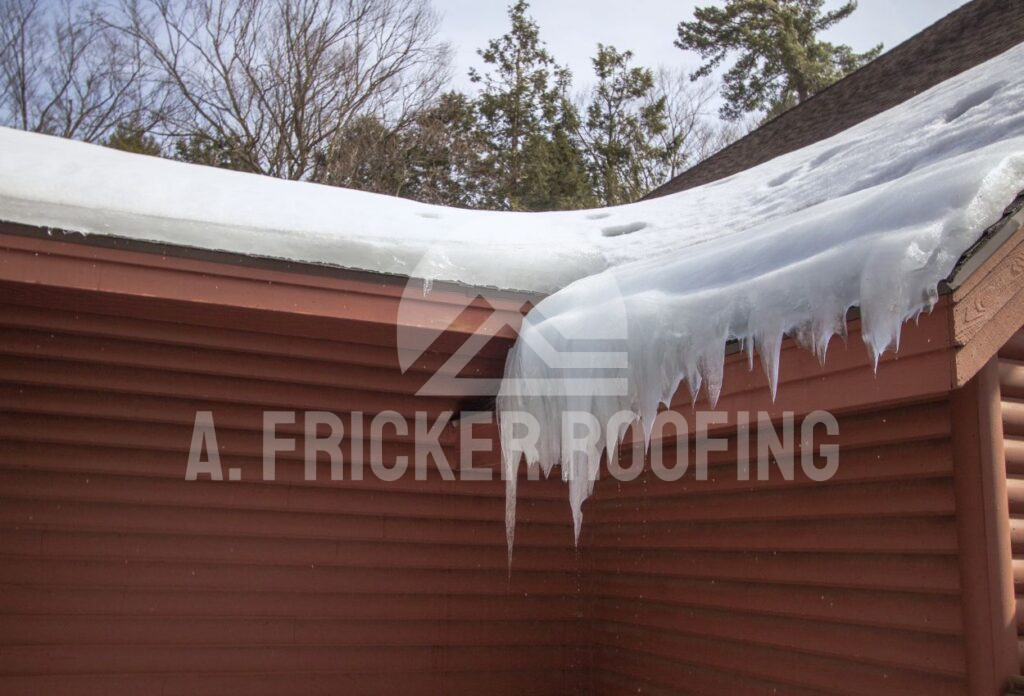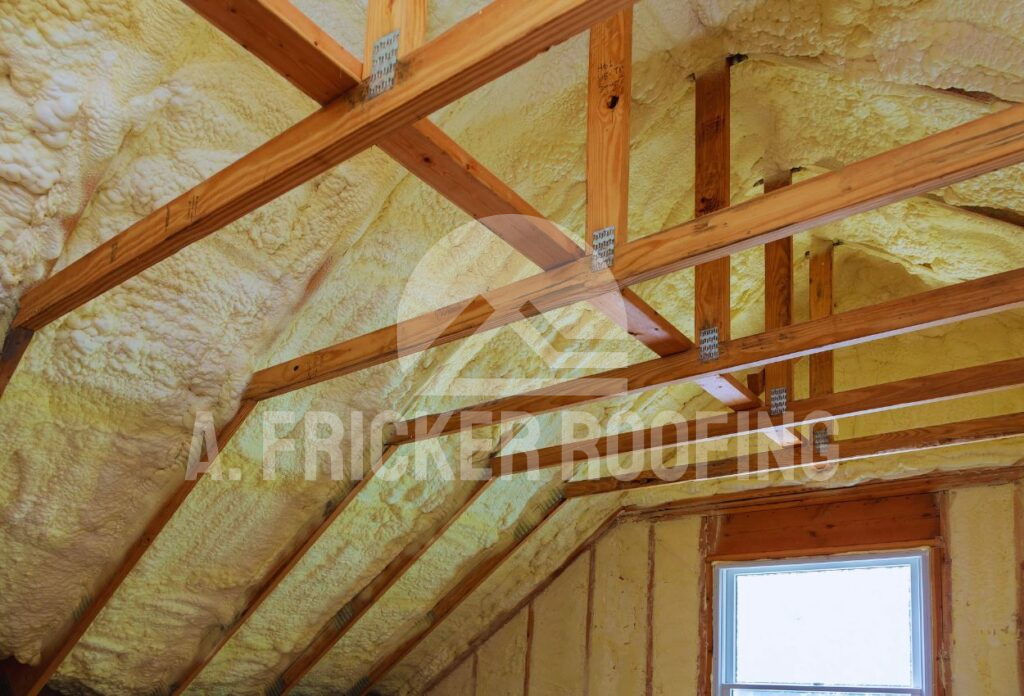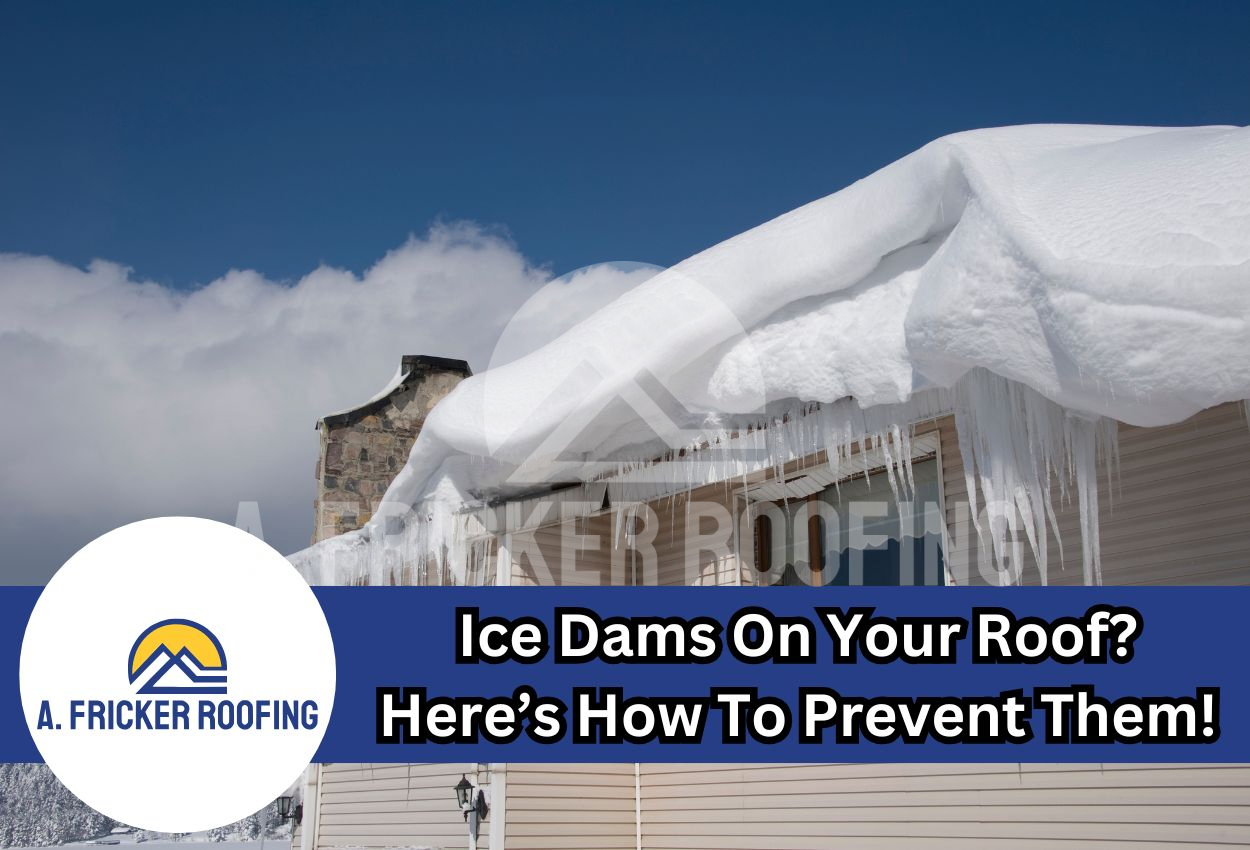Winter is approaching fast in Oklahoma, which makes it the perfect time to prepare your home for what many consider the most challenging season for roofing. Though winters are not as harsh here as it is in some other states, it can still be quite chilly. With the freezing rain and occasional winter storms, this weather creates a silent threat on your roof: ice dams.
If you’ve noticed ice building up along the edges of your roof, you might already have an ice dam forming. In this blog post, we’ll break down what ice dams are, how they occur, and most importantly, how you can prevent them.
What Is An Ice Dam?

An ice dam is a hazardous condition in which water freezes and accumulates to form a ridge along the edge of your roof. When snow melts on your roof, it flows down toward the edges where the temperature is cooler, causing the water to refreeze and form the ice dam.
It’s called an ice dam because, like a real dam, it holds water back.
As more snow melts, the water has nowhere to go and starts backing up behind the dam, pooling and potentially seeping under your shingles. Once water gets under your roofing materials, it can leak into your home, damaging walls, ceilings, insulation, and even structural elements.
How Do Ice Dams Damage The Roof?
Ice dams aren’t just an inconvenience, they can lead to serious damage and costly repairs. Here’s what you’re risking if ice dams aren’t handled properly:
- Roof Damage: Ice dams can loosen shingles and tear off gutters.
- Water Leaks: When water backs up behind an ice dam, it can seep under the shingles and into your home, leading to interior water damage.
- Insulation Issues: Water can soak your insulation, reducing its effectiveness and driving up your energy costs.
- Structural Concerns: If left unchecked, recurring water leaks can cause wooden structural beams to rot and warp.
Can An Ice Dam Occur Without Snow?
As we mentioned earlier, Oklahoma is not a state that witnesses heavy snowfall. So, as a homeowner, you might be thinking you don’t have to worry about ice dams. While we might not get snow, ice dams can still form due to the freezing temperatures during winter.
When a consistent freeze-thaw cycle occurs, rain or sleet can freeze at your roof’s edge, creating ice dams. This is especially true during Oklahoma’s typical winter weather pattern of cold rain followed by freezing temperatures.
Why Do Ice Dams Form?
The root cause of ice dams is a temperature imbalance on your roof. Ideally, your roof should have an even, cool temperature from top to bottom. When the top part of your roof is warmer than the edges, snow at the top melts faster than it can at the eaves, where the temperature is colder. That’s when the water refreezes at the edge and forms an ice dam.
So, why is one part of your roof warmer than another? Here are a few common reasons:
Heat Escaping from Your Home: The biggest factor is typically heat leaking from your attic. If your attic isn’t well-insulated or properly ventilated, the lack of a thermal barrier allows heat to press up against the surface of the roof and causes the snow on the shingles to melt.
Inadequate Ventilation: When air doesn’t circulate properly in the attic, it can create hot spots on the roof, melting the snow unevenly.
Poor Insulation: Insufficient insulation in the attic floor allows warm air from the house to seep into the attic space. This warms the roof and speeds up snow melting.
Weather Conditions: Ice dams are more likely to form when there’s a heavy layer of snow, followed by temperatures that fluctuate right around freezing.
Now that you know what ice dams are and why they form, let’s talk about prevention.
How To Prevent Ice Dams On A Roof
While ice dams can be dangerous, the good news is that with a few practical steps, you can keep ice dams from forming on your roof and enjoy the winter!
Insulate Your Attic

To stop the air leaking from the attic, insulation plays a vital role.
Think of insulation as the key defense against ice dams. By keeping warm air from escaping into the attic, you can maintain a cool, consistent temperature on your roof, preventing the conditions that lead to ice dams.
If you still haven’t insulated your roof, we recommend doing it as soon as possible. You can read about the various types of attic insulation here.
If you have installed insulation, you’ll want to make sure your attic insulation meets the recommended levels for your region. In colder areas, higher R-values (a measure of insulation’s thermal resistance) are necessary to combat winter temperatures.
Seal Gaps And Cracks
Even small gaps in your attic can let warm air escape, creating just the right conditions for ice dams to form. Heat leaking through tiny spaces around attic lights, vents, plumbing pipes, and access hatches can cause parts of your roof to warm up unevenly, melting snow where it shouldn’t. By sealing these gaps with caulk or weatherstripping, you can keep warm air from moving outside. This helps to maintain an even roof temperature and reduces the chances of ice dam formation.
Improve The Attic Ventilation
A well-ventilated attic helps keep the temperature of your roof consistent. This prevents the formation of warm and cold spots that are the primary cause of ice dams. To improve ventilation, you can install roof vents. These exhaust hot air from the roof instead of allowing it to simply push up against the roof itself.
Most homes require a combination of ridge and soffit vents. The cold air flows in at the eaves and exits at the roof’s ridge, creating a steady, natural flow of air that helps keep the roof uniformly cool.
Just be sure that insulation or other materials aren’t blocking these vents, as obstructions can restrict airflow and reduce their effectiveness. Good ventilation works hand-in-hand with insulation to regulate attic temperature and minimize the risk of ice dams.
Also Read: 3 Types of Attic Vents & Best Brands You Should Know In 2024
Regularly Clear Snow Off Your Roof
One straightforward way to prevent ice dams is to clear snow off your roof before it has a chance to melt and refreeze. To do this you can use a roof rake. A roof rake is designed for clearing snow off roofs without climbing up there yourself. You can use it from the ground, so there’s no need to risk slipping on an icy roof. Focus on the lower 3 to 4 feet of your roof to remove snow that’s accumulated around the eaves, where ice dams are most likely to form.
Regular roof maintenance is important to keep your home safe from ice dams and to protect your roofing system from other issues, too.
Keep Gutters Clean

Do gutters cause ice dams? No, it’s a myth that gutters cause ice dams. However, clogged gutters only add to the problem. While it’s not very common, clogged gutters can sometimes contribute to ice dams by allowing water to back up and freeze. Clear out your gutters each fall, especially if you have trees nearby that drop leaves, twigs, or other debris. These prevent roof leaks too.
If you find that your home is dealing with a lot of debris, gutter guards can keep your gutters clear of leaves, reducing the chance of clogging.
Ensure Your Home Winter-Ready With Our Roofing Experts!
Ice dams are one of those winter problems you’d rather avoid entirely. By focusing on the tips we talked about today, you can prevent ice dams from forming in the first place. At A. Fricker Roofing and Waterproofing, we’re here to help ensure your roof stays in top shape all winter. Whether you need to repair your roof, need insulation advice, vent installation, or snow-cleaning help, seek expert solutions to keep your home safe from ice dams.
Contact us today at (918) 402-7167 to learn more about how we can help you.

